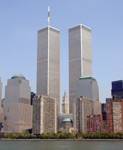City of College Park, Ga. officials announced recently that Iron Sky Inc. will outfit the city with its first street-level video surveillance cameras.

A recently issued report from the Government Accountability Office presented some alarming findings regarding security features in federal facilities.
- By Nelson Ludlow
- Dec 01, 2009

Modeled after London’s “Ring of Steel,” New York City’s Lower Manhattan Security Initiative covers Battery Park to Canal Street -- and when completed, will include more than 3,000 security cameras, 100 license plate reading devices and chemical, biological, radiological and nuclear detectors. All data streams into the Security Coordination Center and is monitored by the NYPD Counterterrorism Bureau.
- By Sherleen Mahoney
- Dec 01, 2009
Activu Corp., a provider in command and control room solutions for homeland security and emergency management announces the successful deployment of a new Joint Command and Control Center for the Port of Long Beach, Calif.

A new report by computer scientists at the National Institute of Standards and Technology demonstrates that iris recognition algorithms can maintain their accuracy and interoperability with compact images, affirming their potential for large-scale identity management applications.
While a majority (57 percent) of Homeland Security professionals say America is safer now than it was before the September 11 attacks, 75 percent believe the country will experience a similar terrorist attack in the next five years -- and Americans aren’t prepared, according to a recent survey commissioned by the National Homeland Defense Foundation and Colorado Technical University.

As we all know, the events of Sept. 11 changed the security industry—and the world—forever. Ten years ago, there was no such thing as the Department of Homeland Security, and transportation security was unrecognizable from what it's become. Today, terrorism and security are consistently popular topics within government policy and in the media. Clearly, it was a day that reinforced the importance of security forever.
- By Megan Weadock
- Nov 06, 2009
GE Security Inc. recently announced that the Pacific Beacon apartments in San Diego, the first privatized community for enlisted single sailors in the country, is being protected by GE Security’s integrated access control and fire/life safety solutions.
U.S. Customs and Border Protection should issue guidance for inspecting cargo arriving in U.S. seaports for biological and chemical threats, the department's inspector general said.
ISC East 2009 has to be considered a complete success. Aisles were packed with end users and integrators, and exhibitors had their “A” game on one.
- By Ralph C. Jensen
- Oct 30, 2009
I missed ISC East in 2008, but it has certainly been worth it this year. As always, New York is alive and in full bloom and the tradeshow is bristling with activity. I’m sure glad I’m here.
- By Ralph C. Jensen
- Oct 29, 2009
CDW Government Inc. recently released its 2009 Emergency Communications Report: Awareness and Progress Toward the National Emergency Communications Plan. The report benchmarks progress toward meeting the goals outlined in the Department of Homeland Security National Emergency Communications Plan (NECP), identifies key challenges and highlights lessons learned.
The city of Wilkes-Barre, Pa., has awarded Schneider Electric a $2 million contract for a wireless video surveillance system. Schneider Electric will design, install and maintain a network of more than 200 digital surveillance cameras located throughout the city’s downtown area, commercial areas, school zones, parks and parking garages.
A recent Harris Poll survey indicates that 96 percent of U.S citizens feel the federal government and law enforcement agencies should be able to use video surveillance in an effort to counteract terrorism and help protect U.S. citizens in specific public places.
Axis Communications recently announced it has won the contract to supply network cameras for Sydney’s new Waratah train suburban fleet. The total installation order is estimated at about 7,000 network cameras.
ICx Technologies Inc.a developer of advanced sensor technologies for homeland security, force protection and commercial applications, announced recently that it has been awarded a Department of Homeland Security contract to participate in a FY2010 mass transit security pilot program.
University of Utah engineers showed that a wireless network of radio transmitters can track people moving behind solid walls. The system could help police, firefighters and others nab intruders, and rescue hostages, fire victims and elderly people who fall in their homes. It also might help retail marketing and border control.
NICE Systems Ltd. Recently announced that it has been selected by Beijing Metro in China to provide NICE's IP video solution, with support for content analytics at certain project locales, to enhance safety and security at the 24 stations of its Line 15 route.
March Networks, a provider of intelligent IP video and business analysis applications, announced recently that the Australian Customs and Border Protection Service has selected the Company's VideoSphere solution to enhance its security operations in multiple airports across the country.
The Transportation Security Administration (TSA) has named Michael A. Scott as federal security director (FSD) for New York’s John F. Kennedy International Airport (JFK).